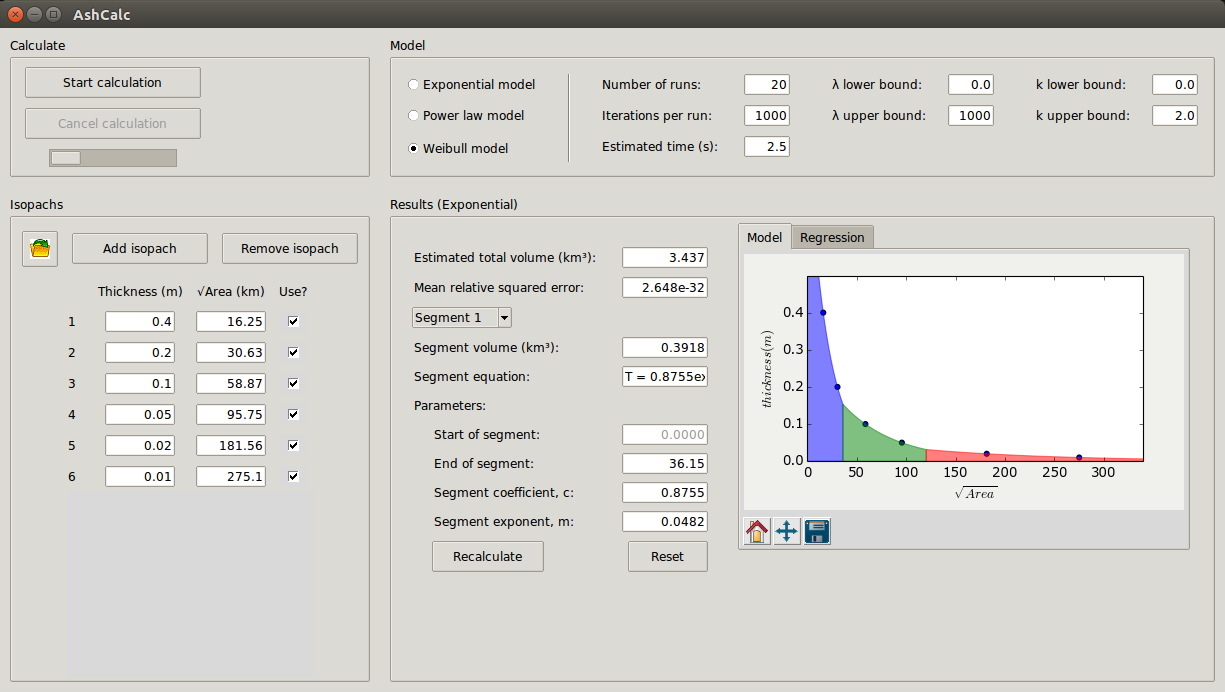AshCalc is an easy-to-use tool that allows volcanologists to estimate the volume of an eruption from isopach data describing the tephra deposits. Volumes can be estimated using the exponential, power-law or Weibull models and the results and quality of the fit can be plotted and compared. For full details, see the following (open access) paper:
Daggitt ML, Mather TA, Pyle DM, Page S (2014) AshCalc–a new tool for the comparison of the exponential, power-law and Weibull models of tephra deposition. Journal of Applied Volcanology 3:7. doi: 10.1186/2191-5040-3-7
AshCalc is distributed as a series of Python modules under the open source MIT license. The software includes:
- a graphical user interface
- a command line interface
- the Python source code for the calculations, which is extensible and should be easy to integrate into other projects.
For each model the outputs of AshCalc include:
- Total estimated tephra volume
- Model equations
- Model error
- Model parameters
- Regression parameters (Exponential and Power law models).
For detailed instructions, download the AshCalc user manual.
AshCalc can be installed by downloading and unzipping onto a folder on your local machine. Alternatively, git users can simply clone the repository as follows:
git clone https://github.com/MatthewDaggitt/AshCalcAshCalc requires Python 3 and a number of additional packages (e.g. numpy). The extra packages can be added to an existing Python 3 installation using pip by running the command below in the AshCalc directory:
pip install -r requirements.txtThe recommended method for a new installation of Python 3 is to use the Anaconda Python distribution. This is a free software package that contains all the necessary tools to use Python for scientific data analysis. It is available for Windows, Mac and Linux and includes options for creating 'virtual environments' that allow specific versions of Python packages to be used for different projects. The AshCalc user manual describes how to set this up.
AshCalc can be run by opening a terminal window in the AshCalc directory and entering the following:
python3 ashcalc.pyThis will open the graphical user interface, which allows interactive tweaking of input parameters and visualisation of the output. AshCalc also has a command line interface. This is useful for automatic processing of multiple files. Run the following to see instructions:
python3 ashcalc.py --helpThe example command below will fit a 3-segment exponential model to all the csv files in the directory and creates plots of the fit.
python3 ashcalc.py *.csv --plot --model exponential --segments 3Results are printed to the terminal and can be captured using the redirect command.
python3 ashcalc.py *.csv > my_results.txtA cut-down version of AshCalc is also installed on VHub. It requires no download or setup, but it won't plot error surfaces for the Weibull model and has much coarser-grained controls.
